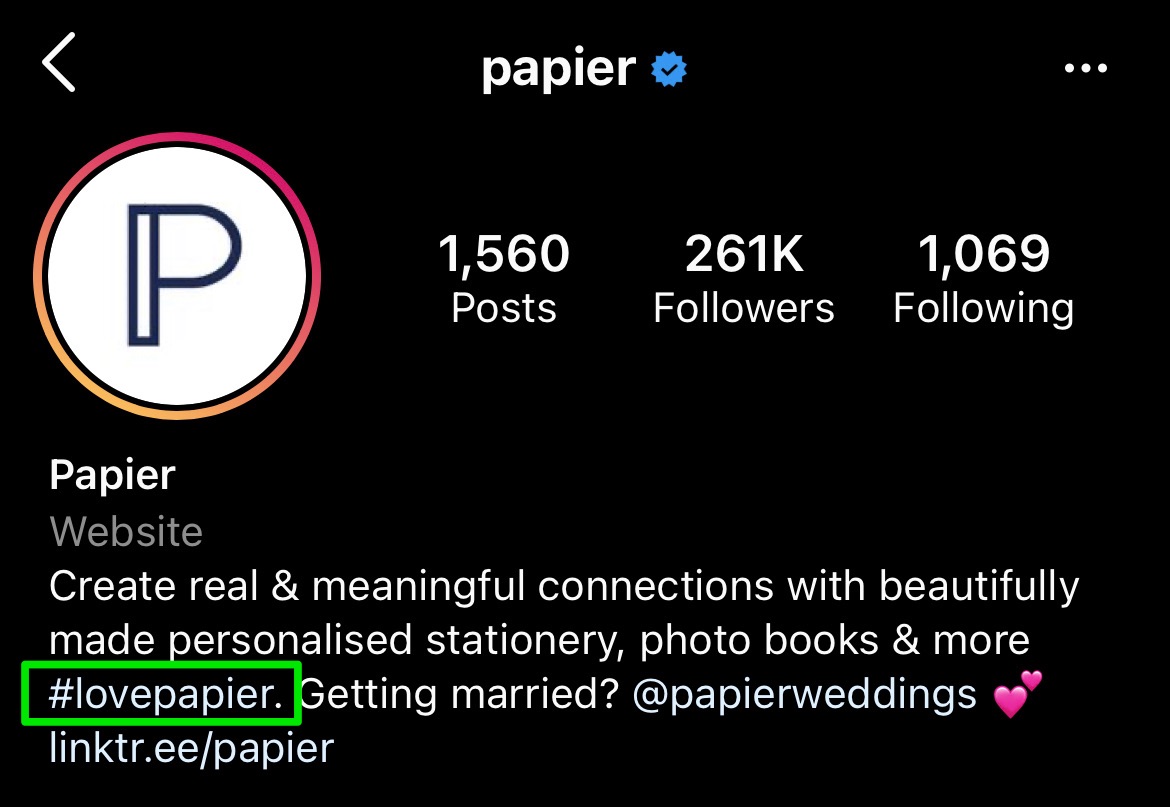Quick: what’s in your Instagram caption? Is it #love and #instagood? Or is it more #branded? How much time do you dedicate to thinking about your Instagram hashtags? If you’re dipping your toes in the hashtag waters, it might feel like more is better but this isn’t always the case. Read on to learn more about how using hashtags on Instagram could benefit your brand and how to put these strategies into action.
5 Benefits to using Instagram hashtags
Why should you as a brand even care about hashtags? There are a number of benefits that you get from using hashtags on Instagram. No matter what your social media goals are, there’s an #advantage for everyone.
1. Increases exposure & discovery
The biggest reason for using hashtags is for the increased exposure and discovery. Clicking on a hashtag in Instagram leads to a gallery of both the top posts and latest posts that used the hashtag. From there, you’re able to explore all the related posts, making hashtags a great way for people interested in a certain topic to find more accounts to follow. This means that if you use the right and most relevant hashtags for your brand, others searching on that hashtag will find those posts. Your audience can use branded hashtags to show off their experiences with your products or services as a form of brand advocacy. Hashtags are good for overall brand exposure. Even clicking through one post on the search results page will lead you to other similar posts.
2. Encourages audience interactions
When you use branded hashtags and encourage their use, it becomes another form of engagement. Tagged feed posts are saved in search results and tagged story posts are saved for the duration of the story. Think of hashtags as just another way to reach and engage your customer base.
3. Competitor analysis
How much digital space are your competitors taking up in your market? Hashtags help you analyze your share of voice on social media. Chances are that you and your competitors will have overlapping hashtags, especially if they’re industry and local ones. In an ideal share of voice situation, your posts and ones that your customers have tagged are taking up the bulk of those hashtag search results. You can also check out posts with your relevant hashtags for content inspiration and to get ideas on where your brand might be falling short compared to competitor content.
4. Content research
Similar to what you would do for SEO keyword research, hashtags can help you research different content ideas. Say you want to increase your share of voice in the #naturalskincare hashtag. That’s rather tough since there are over 6.9 million posts with the hashtag.
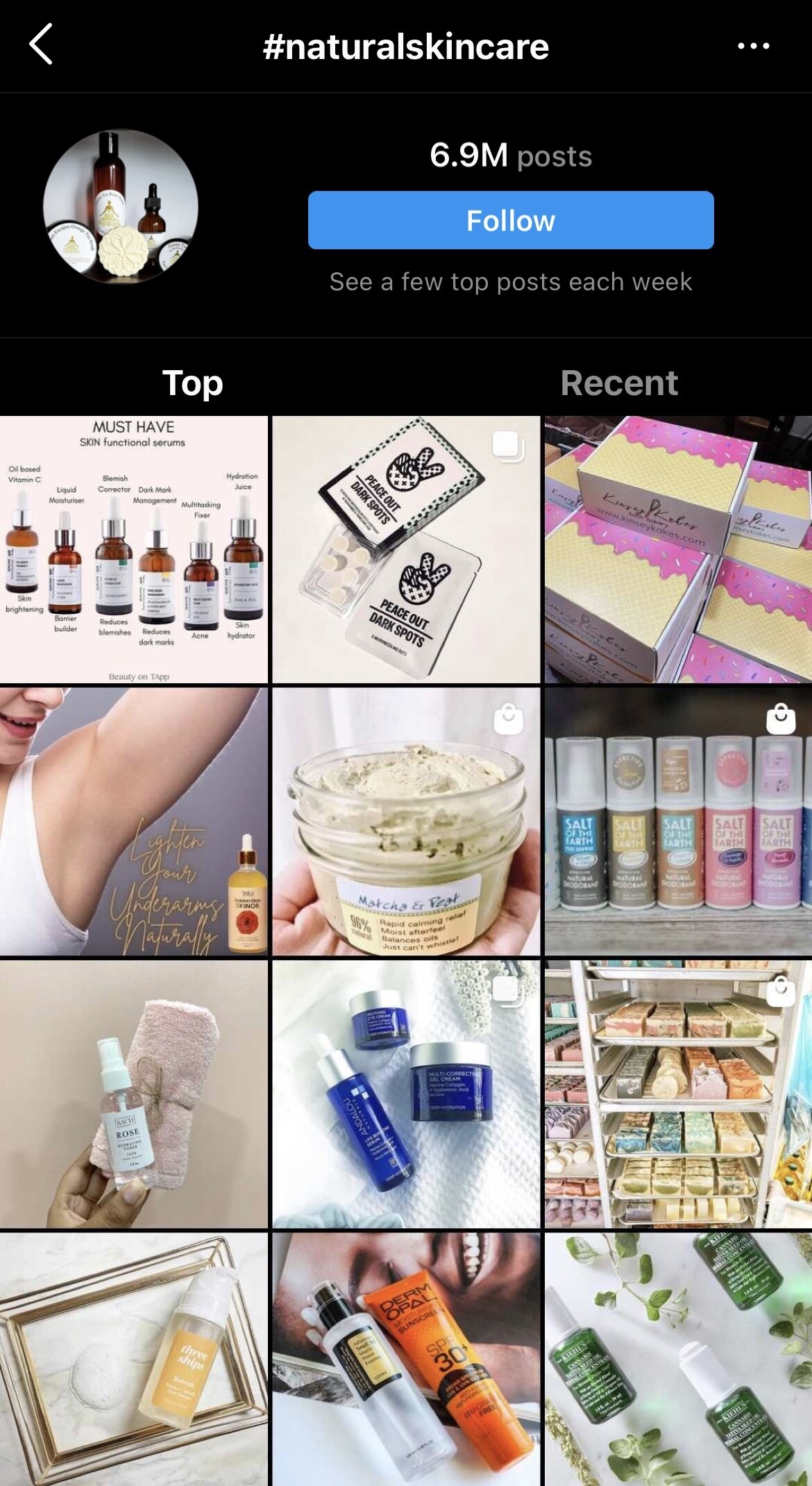
However, you can use the search results page’s Top tab to see what the best posts have been. Use this area as inspiration. What seems to be working for similar brands? Is there a certain style or caption that’s trending now? By clicking into top posts for details, you might also be able to find additional hashtags that are less highly populated, but just as relevant to your audience, similar to secondary keywords for search optimization.
5. Links digital and IRL campaigns
Go shopping in any retail store these days and chances are that you’ll come across a marketing campaign with a hashtag attached. Whether they encourage you to use their general brand hashtag or a campaign one, hashtags offer an easy way to connect digital and in-real-life campaigns.
7 Best practices for Instagram hashtags
Is that post #cool and #creative? Gone are the days where hashtags were still new and brands threw in every popular hashtag they could think of, regardless of its relevance. We’ve reviewed the ways that using hashtags can benefit you, now it’s time to understand the best ways to use them. There’s no single right way to use hashtags on Instagram but there are definitely some best practices. Here are seven to think about.
1. What’s the optimal number?
This is a tricky question because the answer varies wildly. Within a caption, it’s recommended to use 1-3 hashtags. If you enter more hashtags as the first comment, then up to 30 hashtags would be acceptable. However, this is not to say that you should use 30 hashtags for every post. This leads us to the next tip.
2. Use hashtags in the first comment
Too many hashtags in a caption overwhelm valuable real estate and can make it look messy. Keep the caption minimal and if you’re using more hashtags, move them to a comment. With Sprout’s Compose feature, you can schedule the first comment along with your Instagram post and caption.
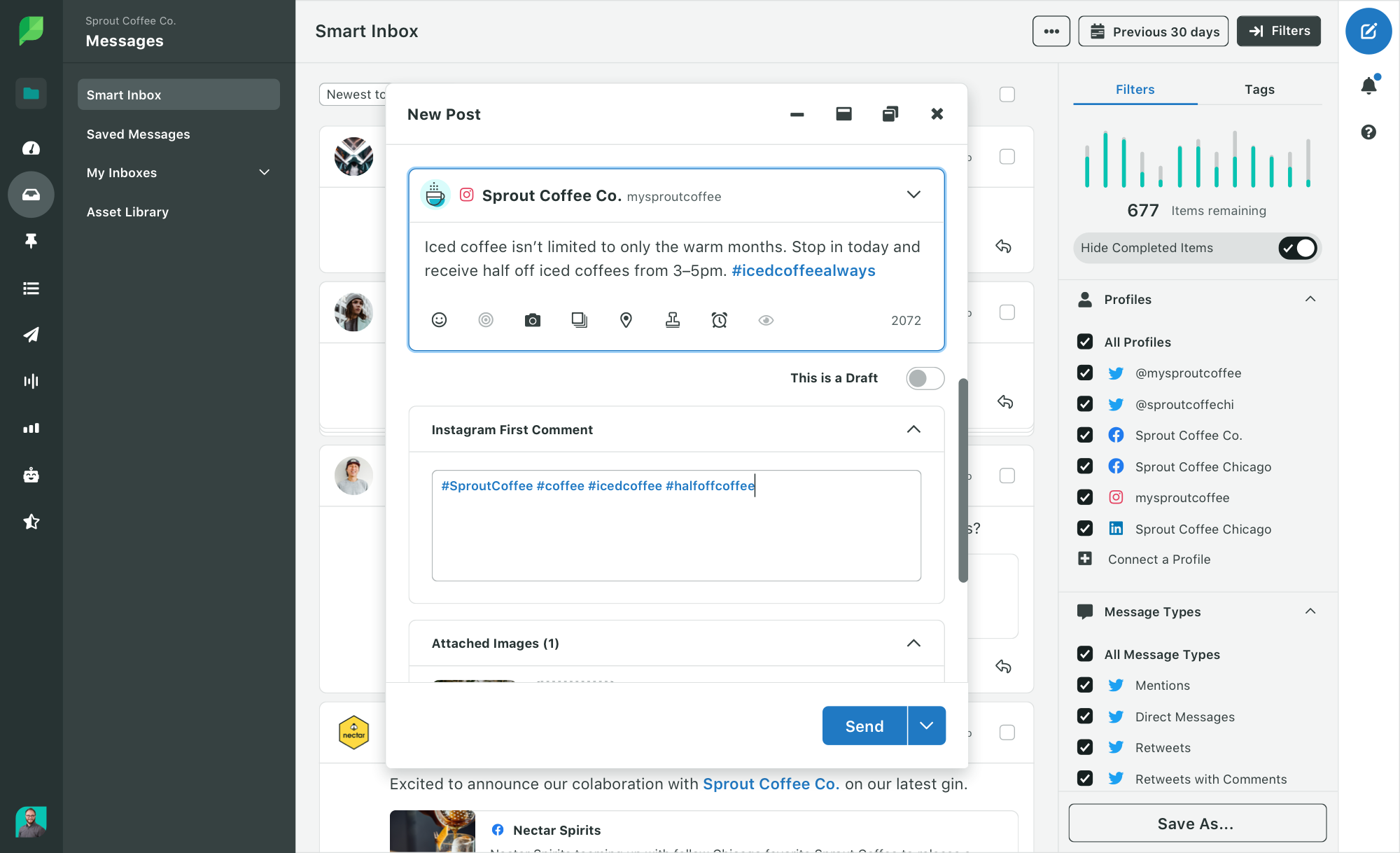
3. Find the best hashtags for you
There are several ways to find the best hashtags for you. The first and easiest is to look at the influencers and accounts you already follow and note which hashtags they’re already using. Another way is to begin brainstorming various ones and type them into the Instagram search bar. As you type, related hashtags also show up.
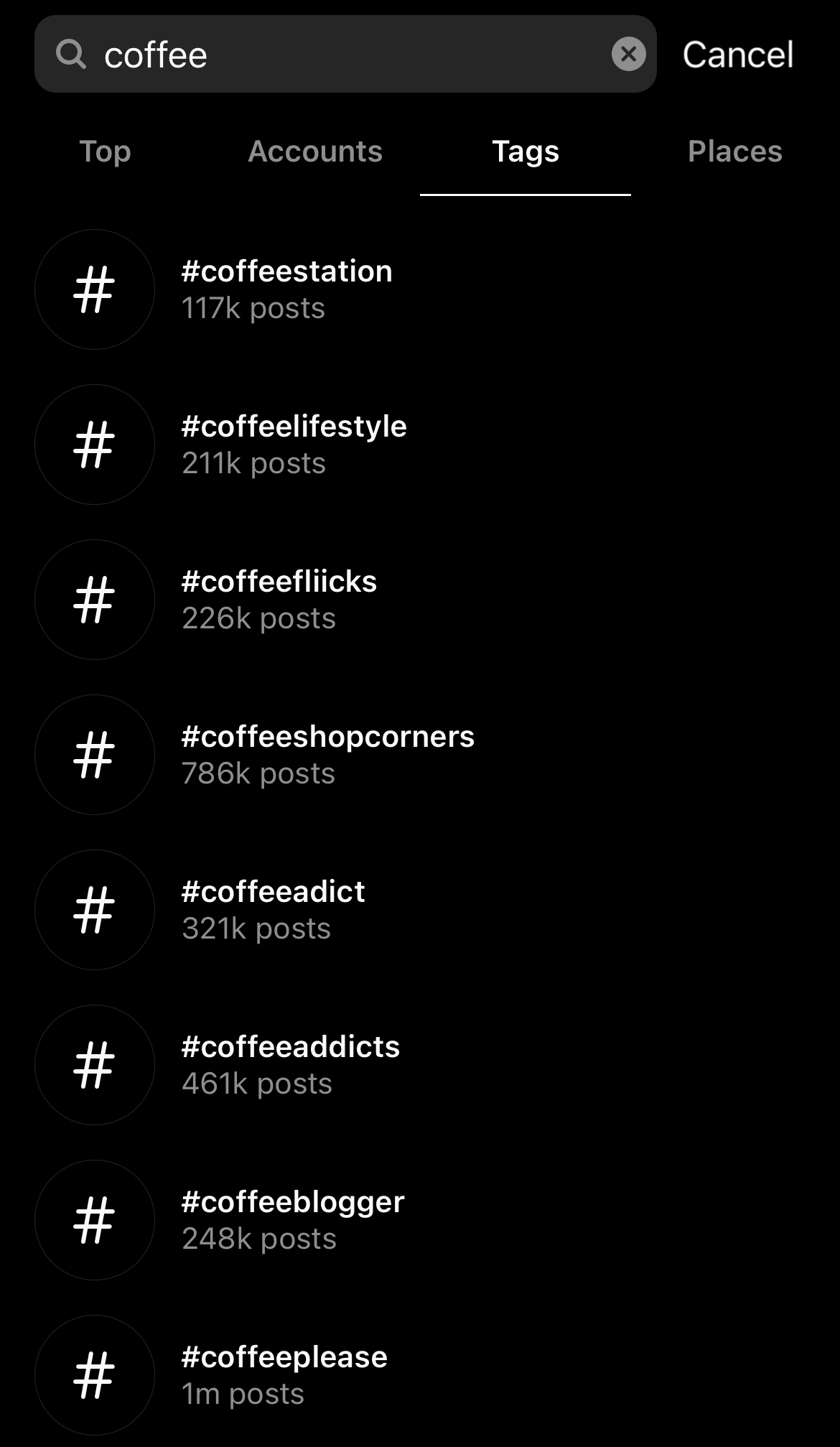
In the example above, #coffee is such a popular hashtag that using it might result in more spam comments than you want. Instead, scroll further down the results to find more niche ones that are targeted and relevant to your audience.
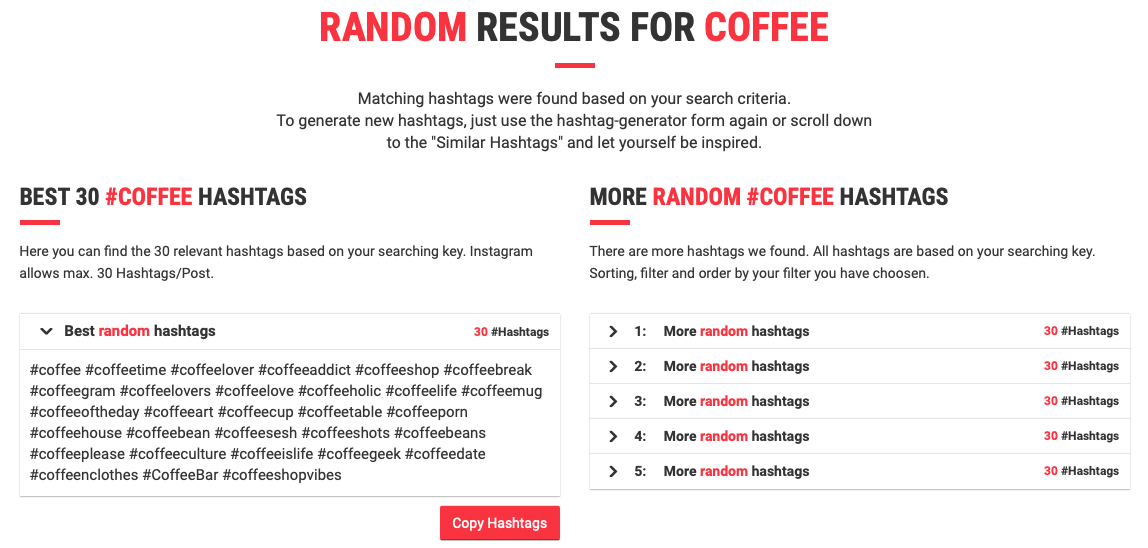 Another way to find relatable hashtags is to use a service like All Hashtag to generate related hashtags based on ones that you enter.
Another way to find relatable hashtags is to use a service like All Hashtag to generate related hashtags based on ones that you enter.
4. Follow hashtags
Instagram offers the ability to follow any hashtag’s search results. When you do this, these posts appear in your feed, alongside all the other posts from accounts you follow. This is a good tactic to use for following industry or community hashtags because it helps you keep tabs on them. It should not be used as a solution for branded hashtags, though, because it doesn’t guarantee that every post will show up in your feed. 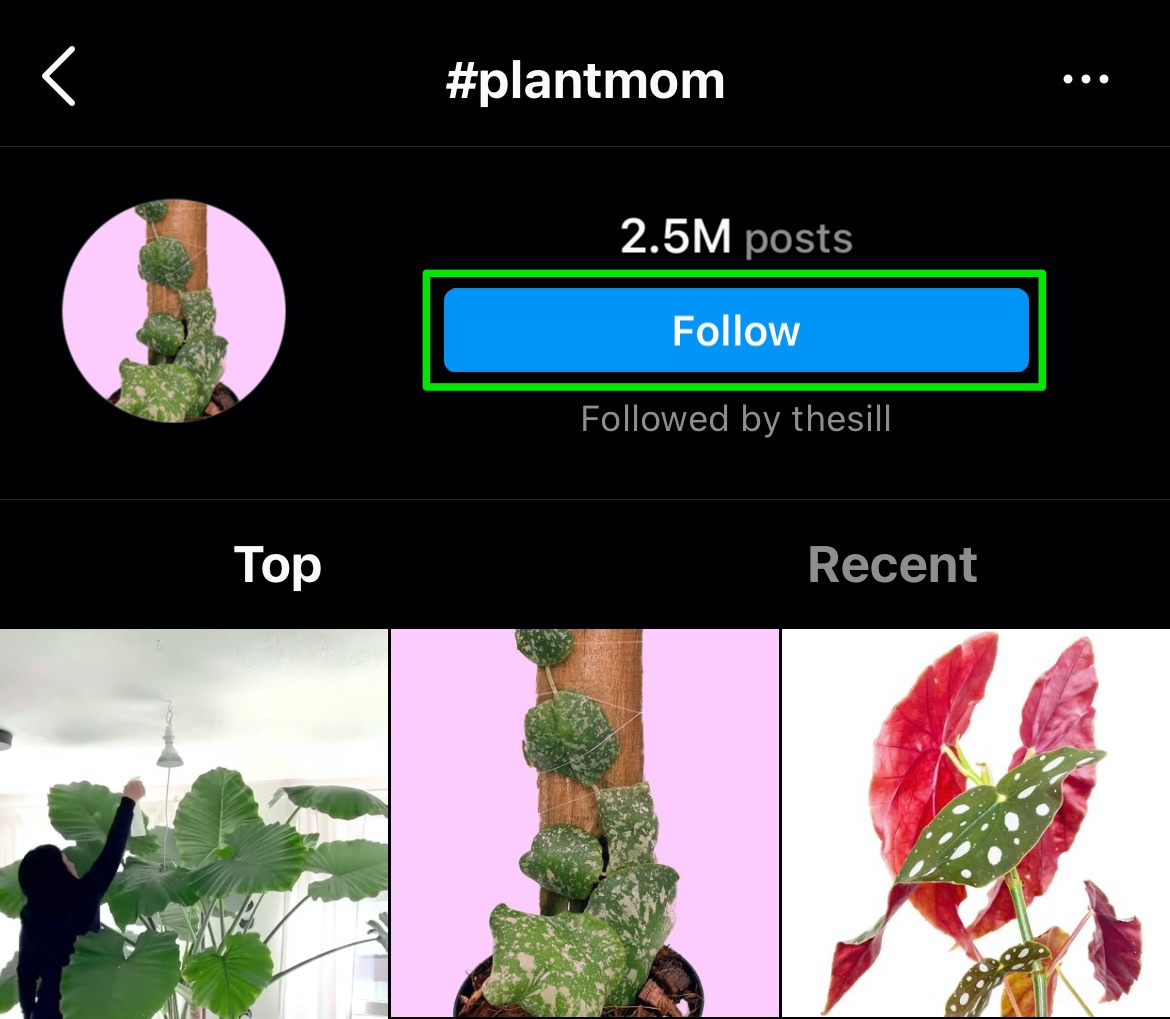
5. Encourage the use of branded hashtags
Once you’ve created your list of branded hashtags, make sure to start using them in every relevant post. The most general branded hashtags are often placed in the Instagram bio along with a call-to-action for using them.
In the above example, Papier puts their branded hashtag in the bio. Customers then use this hashtag whenever they post about the brand. On Papier’s end, they utilize a user-generated content strategy and regram the photos.
6. Keep hashtag lists for easy access
Instead of copying and pasting the same set of hashtags for every post, divide them up into topical ones. For example, your education posts might have different hashtags than a new product announcement post. Instead of generating a new list for each post, keep different lists handy for the various types of content topics that you post.
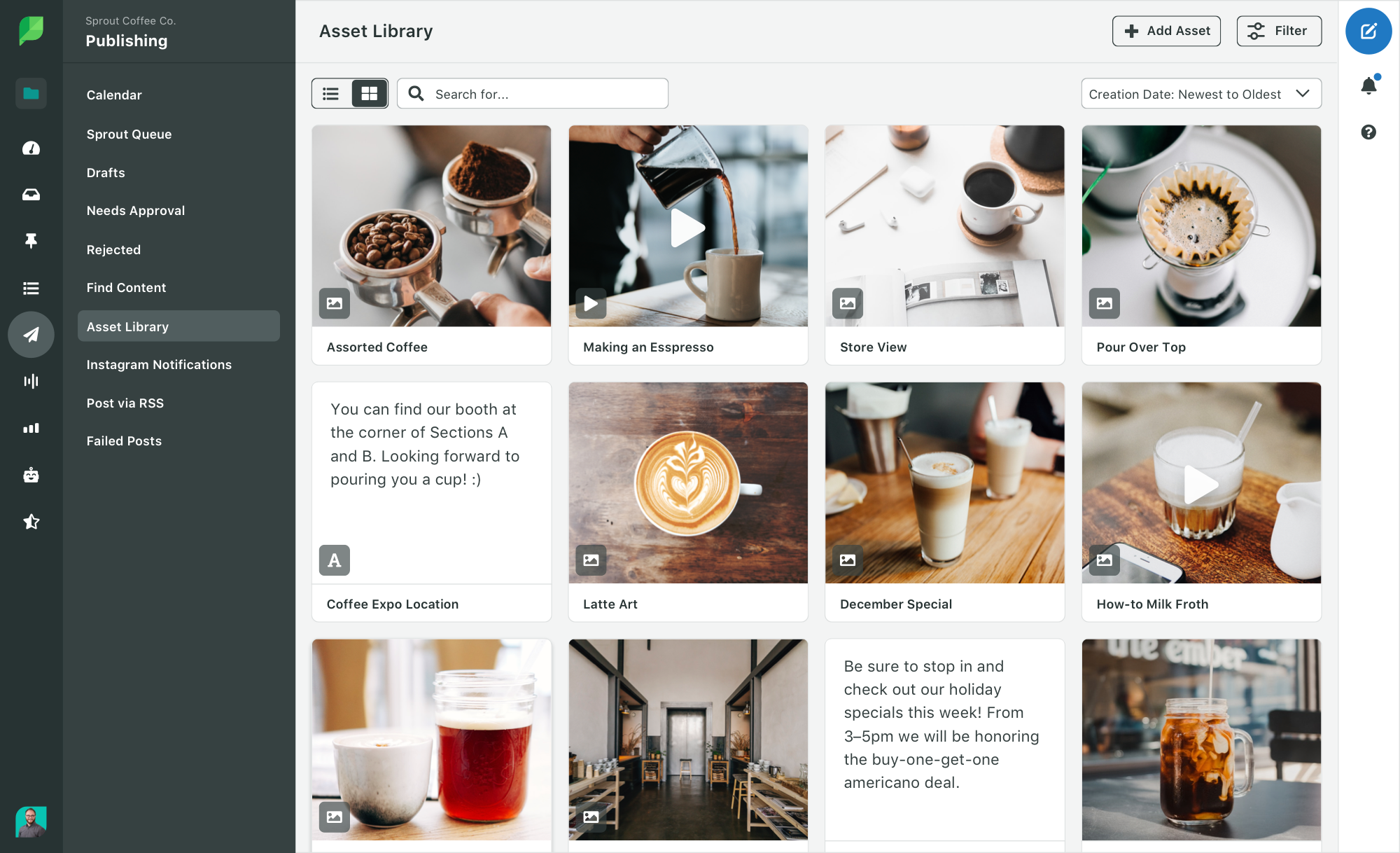 You can save this type of text in Sprout’s Asset Library to make it easier to attach the right hashtags to each post.
You can save this type of text in Sprout’s Asset Library to make it easier to attach the right hashtags to each post.7. Don’t forget to add hashtags to Instagram Stories
While Stories do disappear after 24 hours, don’t discount the use of hashtags on them. These show up in the search results, too, and are another easy way of getting more interested followers. Have too many hashtags to put into a Story? Enter your text like normal and then hide them behind a gif or sticker.
Different types of hashtags
There are several different types of hashtags that brands should know about. Each has its own benefit and application.
Branded & product hashtags
If you’ve been managing a brand presence on Instagram for a while, chances are that a version of your branded hashtag already exists, whether or not you were the one who came up with it. Branded hashtags are oftentimes the brand’s name, a brand slogan or related to a brand community. The former is the one that probably already exists for your brand. The latter two will need to be created and used by you. Product hashtags tend to combine your brand name and the product name. This way, you can track posts not just by your overall brand but to specific products. Creating a hashtag for your brand is simple and can easily carry over into your other social media platforms.
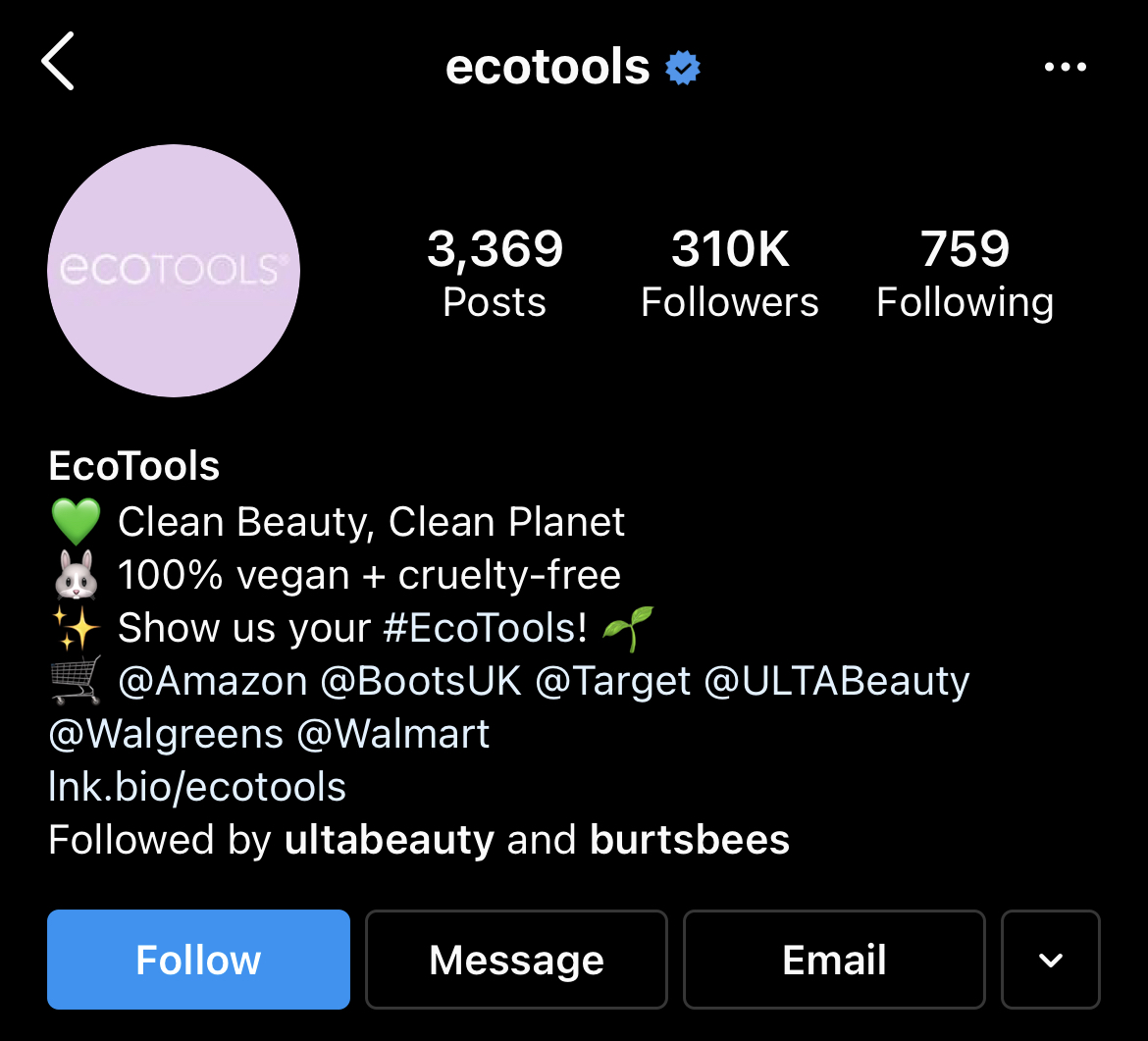
For EcoTools, their branded hashtag is their name. To encourage the use of it, the company put the hashtag into their Instagram bio and paired it with a call to action. It’s on every brand post and on many of their customers’ posts, totaling up to over 131k on that hashtag alone.
Campaign hashtags
Campaign hashtags are specific to marketing campaigns that you’re running. Usually, these involve the brand running a regular campaign and adding a hashtag to it in a caption or in the corner of the post. On television ads, you’ll find them resting in the corner for the subtle effect but they could be very prominent if the campaign is centered around the hashtag itself. One example of a campaign hashtag is the #jungalowxtarget one used to promote their recent collaboration. For all posts related to this campaign, both Target and Jungalow will use the unique hashtag. After the collection is available to purchase, customers will also use the hashtag to document their sightings and purchases. Campaign hashtags don’t need to be tied to a product or sales. REI’s #OptOutside campaign encouraged people to go out rather than shop on Black Friday, and therefore wasn’t centered around purchasing.
Community & industry hashtags
Nearly every community and industry has at least one hashtag that’s used within them. To find yours, head to some popular community and industry influencer posts and check out their hashtags. Many of these hashtags are simple. The hashtags that are easy to think up are usually the most used.
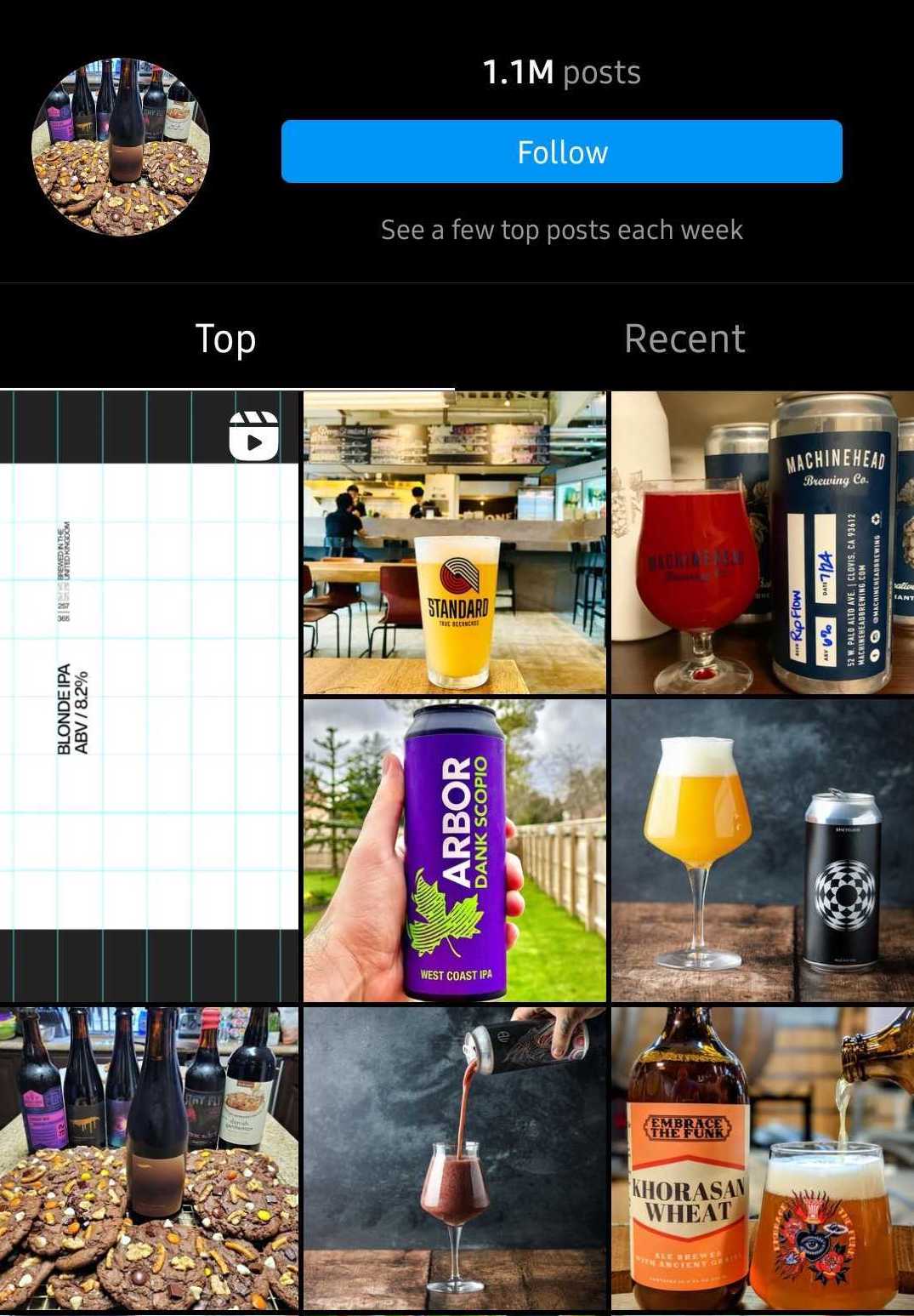
For craft beer enthusiasts, several exist: #craftbeercommunity, #craftbeergeek and #craftbeerenthusaist are just a few of them. As you can see, all three of these are pretty straightforward and natural to think up, and include in posts for relevant brands.
Location hashtags
Location hashtags are pretty self-explanatory. Most brands are based somewhere and if you have a physical location, this is even more useful for you. Relevant location hashtags include your city and its associated topical hashtags, your neighborhood, the mall name you’re in and any other defining features.
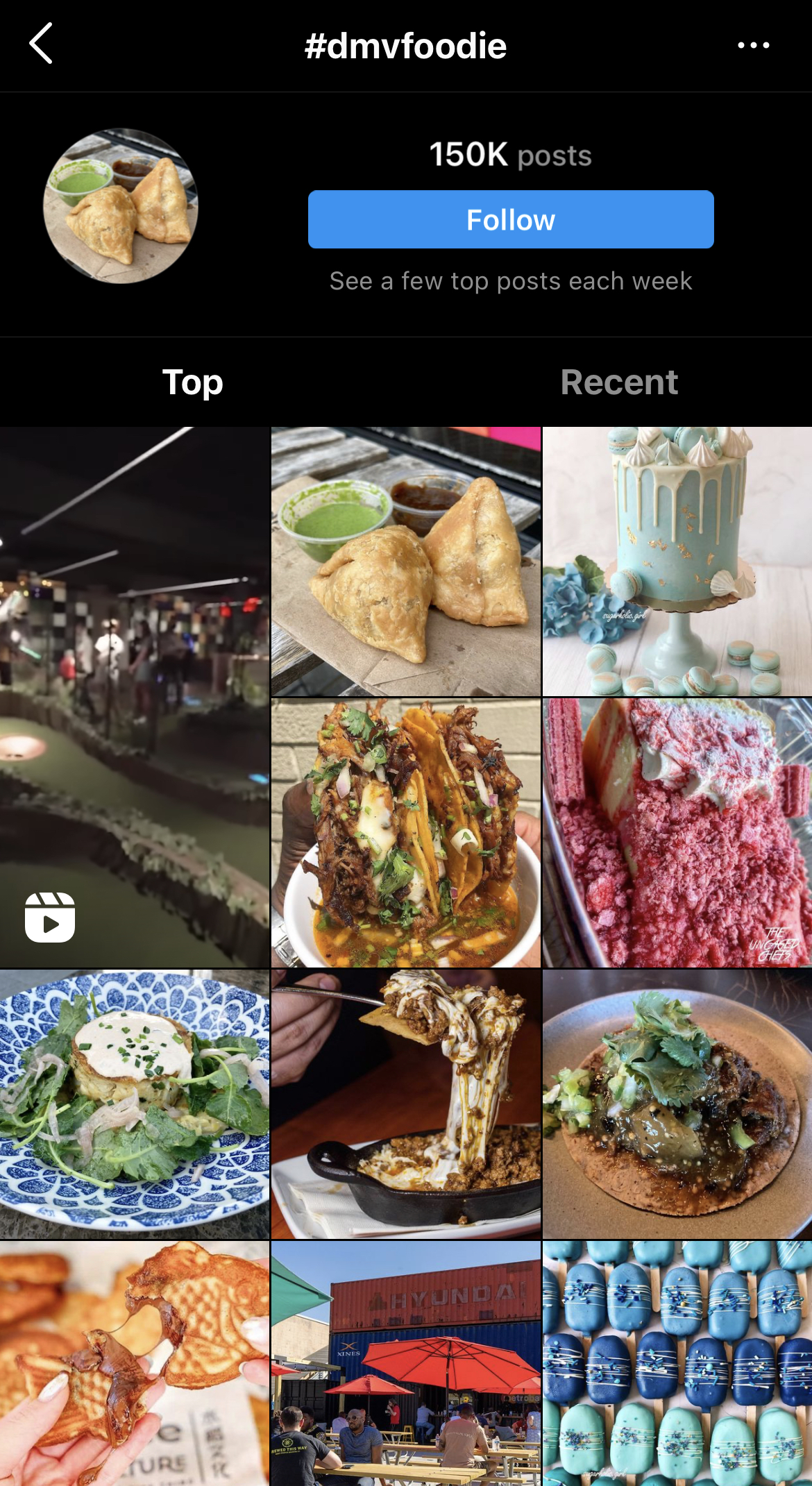
One example is the above #dmvfoodie. This is one of those location + topic hashtags. The posts tagged with these are relevant for anyone searching for food recommendations or users in the DC metro area. Other location hashtags to explore include any branded ones that your city’s and state’s tourism boards have already established.
Themed hashtags
Have you ever seen a post about a national food day and wondered who the heck comes up with them? Although national hashtag days are often fairly arbitrary, they’re still fun for audiences to participate in and get attention for specific topics. So when a day comes by that matches with your business, why not join in?
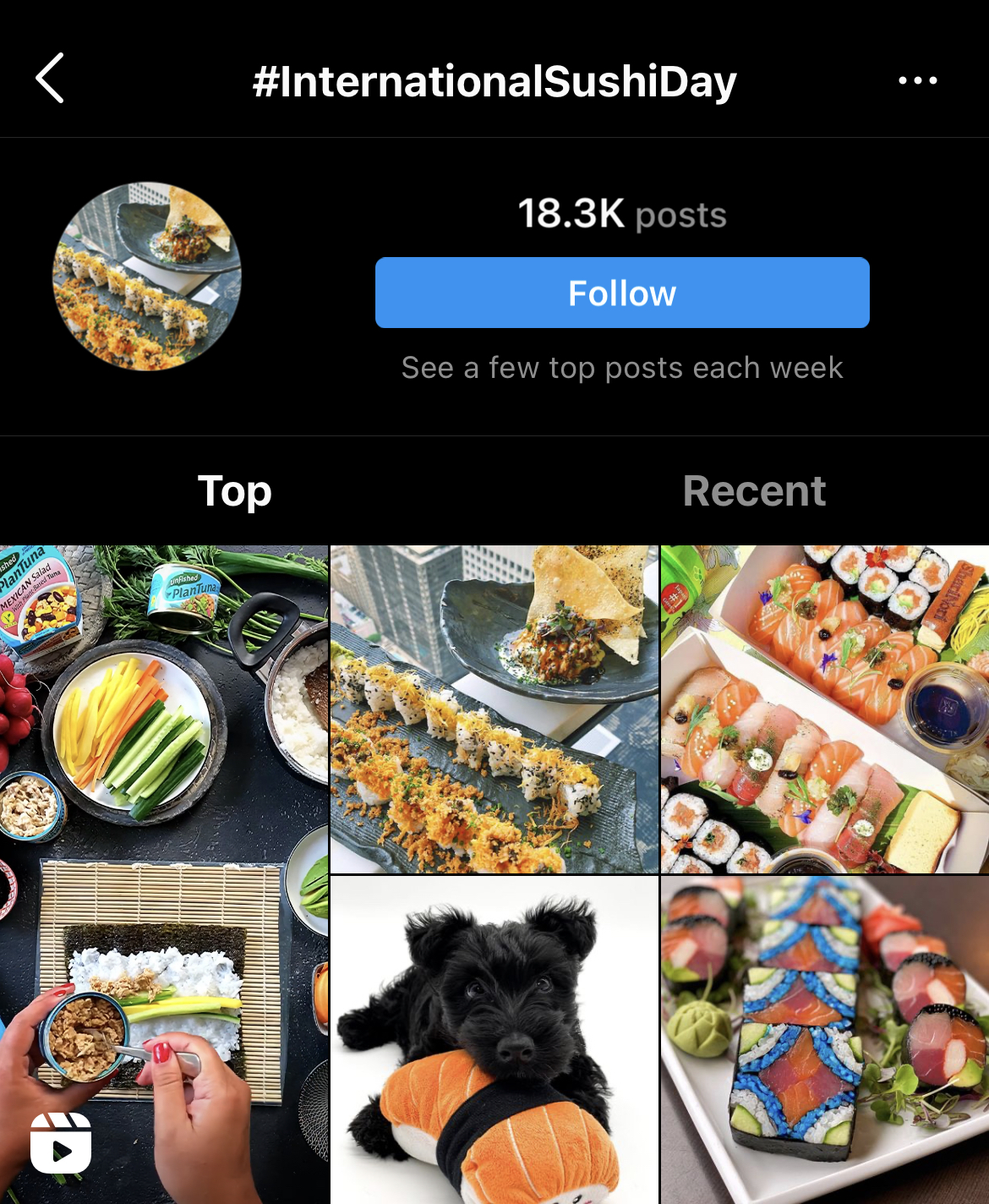
For example, International Sushi Day is on June 18, and on Instagram, the hashtag has over 18k posts. You don’t need to be in the sushi business to post about this, you only need to be related to it. Maybe you work with or are friends with a local sushi business. Feature them in a post to help promote them. To make planning content for these easier, add them to your social media calendar.
Daily hashtags
Daily hashtags aren’t limited to Instagram and they’re easy to find. These hashtags start with the day of the week and then follow up with the topic. There are generalized ones such as #MondayMotivation and #ThrowbackThursday. Nearly any brand can take part in these, and there are plenty of niche topics covered.
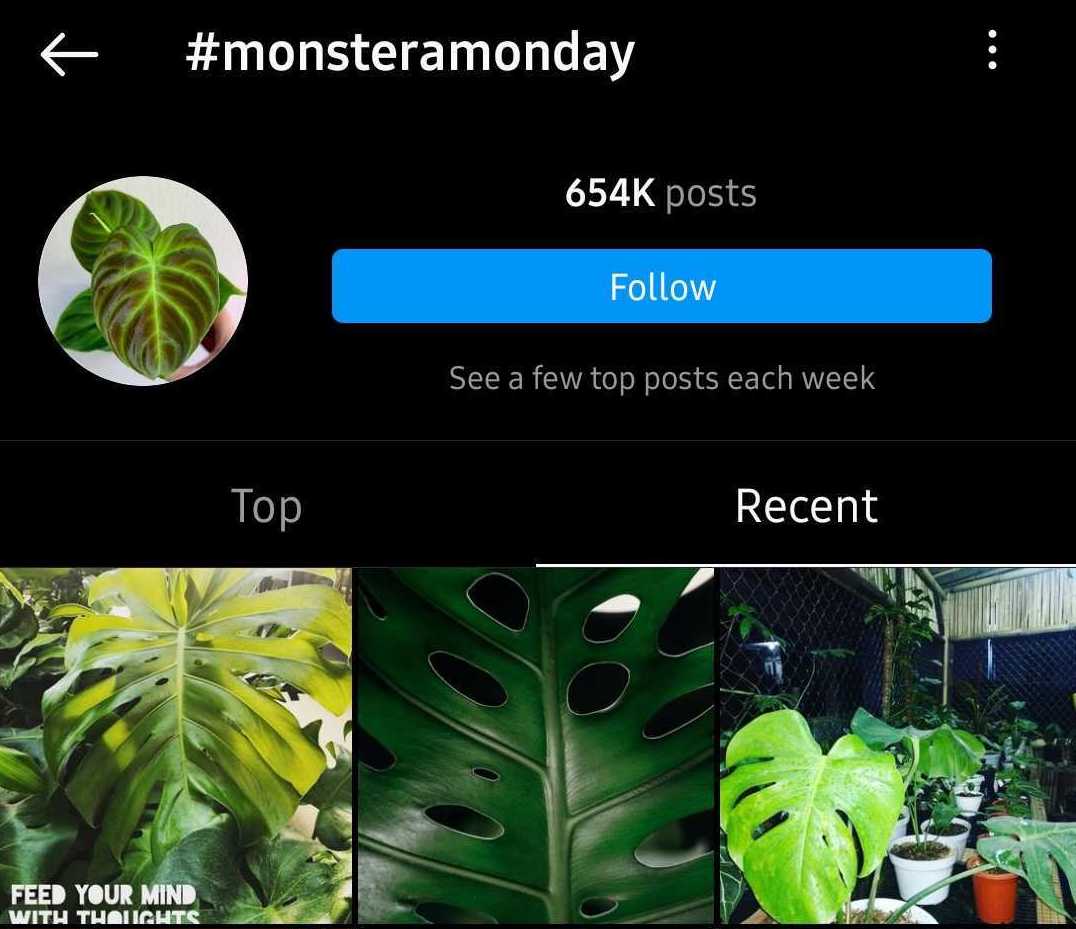
These hashtags cover more interest-based topics and also happen to be daily. For example, on #MonsteraMonday, plant lovers post a photo of their monstera plants. These daily hashtags take a little more work to find but if you’re following influencers in specific fields, you’ll see them come up.
Trending hashtags
This type of hashtag is one of the more difficult ones to post since it involves keeping tabs on the latest and knowing how to apply them to your brand.
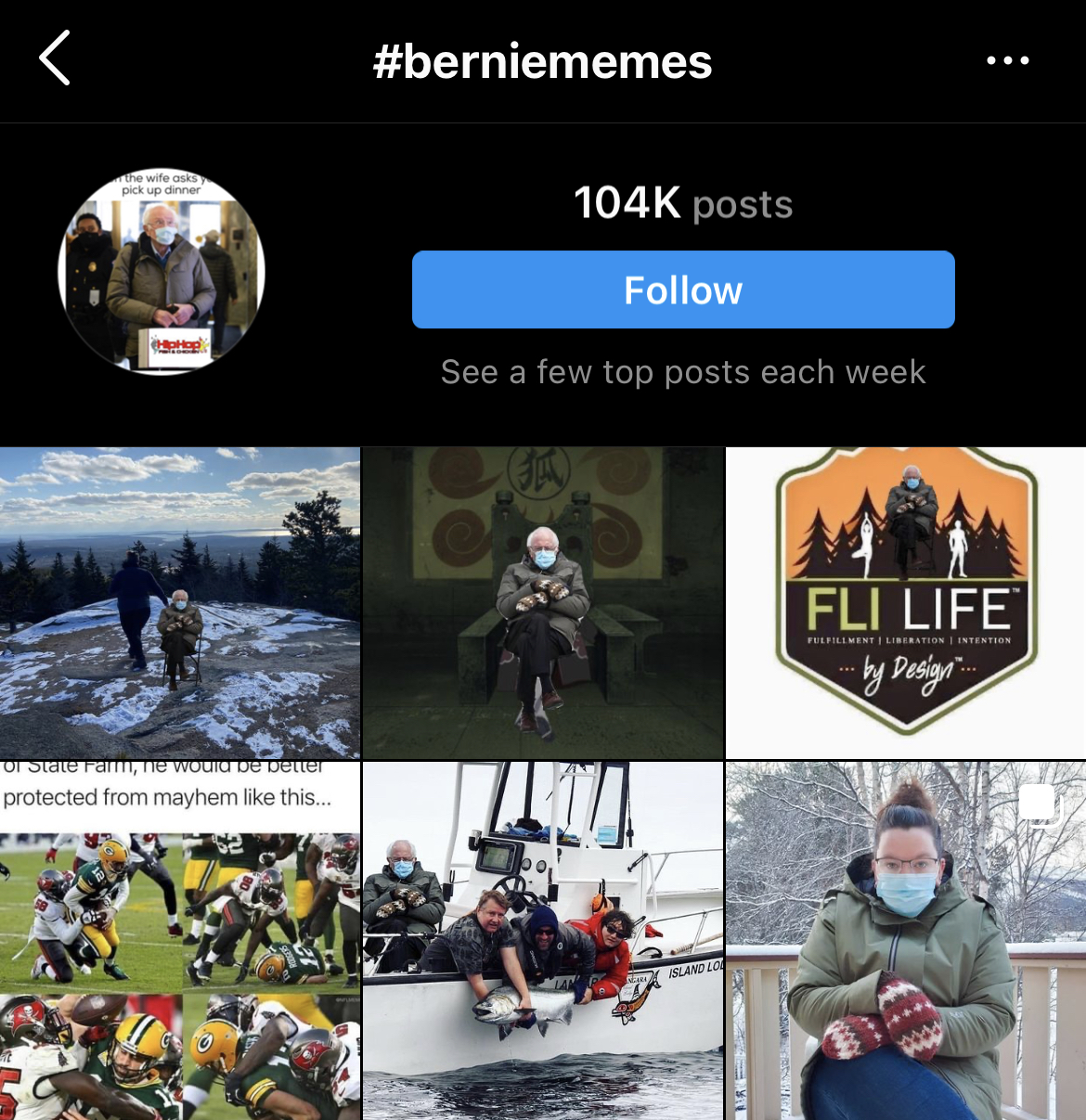
For example, the image of Bernie Sanders sitting in a chair with mittens and a face mask on became an instant meme. The image was superimposed nearly everywhere imaginable by both individuals and brands alike. But, like memes and trends are, it was short-lived. If you caught on early and participated, then you were able to reap the benefits of jumping on the trend. You may need to up your trendspotting skills for social media to get the most out of jumping on memes and trends in a timely and brand-relevant way that resonates.
Ironic or commentary hashtags
These take a little more humor and are not often used by brands. Ironic or commentary hashtags are tied to the caption and usually at the end of it. These hashtags are not added to be searched on or to promote anything. They’re tongue-in-cheek or sarcastic in nature. For brands, these are not the most useful hashtags but might be relevant if your brand voice fits this kind of humor.
Banned hashtags
And lastly, let’s cover banned hashtags on Instagram. There’s a list that’s constantly being updated of hashtags that, when used, will not generate search results. Some hashtags, usually offensive or spam ones, trigger a flag on your account. Others might get added because the newest posts have been identified as spam content. There are several ways to find out if the hashtag you’re thinking of using is banned. When you start searching for them, they won’t show up in the search results as you’re typing. The search results won’t have the Top and Recent tabs. If you’re adding it to a post, it won’t prompt as an autocomplete. Sometimes, they won’t even show any results or will have a warning about the hashtag. While these terms are generally not likely to be in your brainstorming for brand-relevant content, it’s good to fully understand how the platform is monitoring the use of hashtags and enforcing community standards.
Tracking & analyzing Instagram hashtags
So you’ve decided on all of your hashtags and you’re ready to get started on the new social strategy. What’s next? Checking in on how all these hashtags are working out for you. As you start to use the same hashtags, you’ll start noticing when you receive more engagement or more spam comments. To make sure that you’re using the right hashtags for you, find a social media tool that offers hashtag analytics.
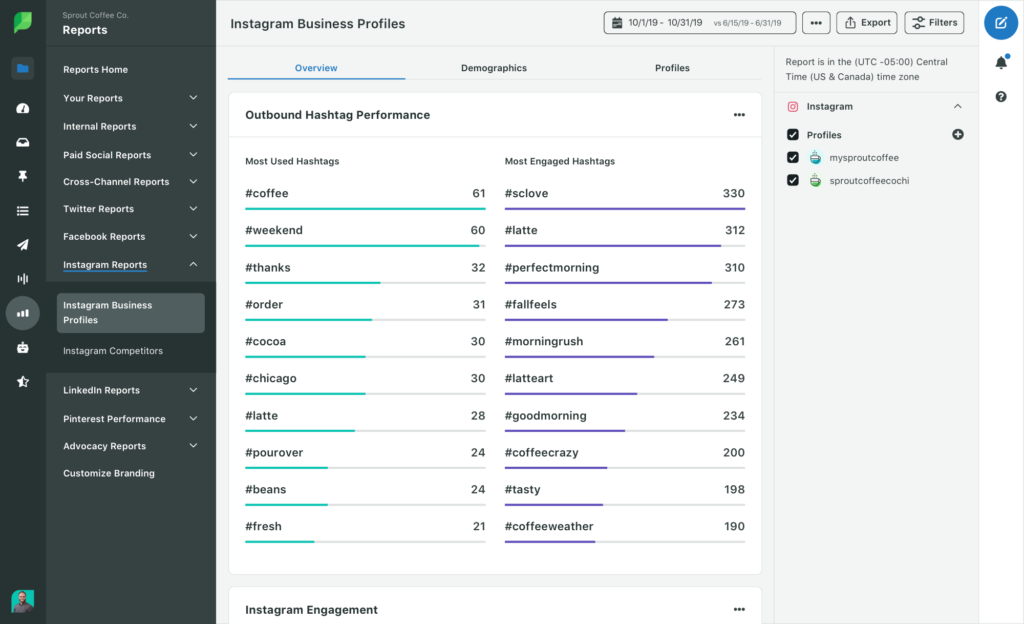
The Outbound Hashtag Performance chart in Sprout’s Instagram Business Profiles Report keeps track of all the hashtags you use on posts and their performance. With one glance, you’ll notice which ones you use the most of and which ones get the most engagement. These two may not generate the same results, especially if you’re switching up the hashtags for posts. By reviewing your analytics, you might end up finding that your most relied-on hashtags are not actually the ones resonating the most with audiences.
Brands should use hashtags on Instagram
Using hashtags on Instagram has many benefits for brands: increased brand exposure, increased engagement and competitor analysis insight. Before jumping into hashtags, it’s recommended to understand the different types that are out there and some best practices to follow. Ready to get into more #InstagramStrategy? Take a look at how to create an Instagram strategy for your brand.
The post All about Instagram hashtags for brands appeared first on Sprout Social.

